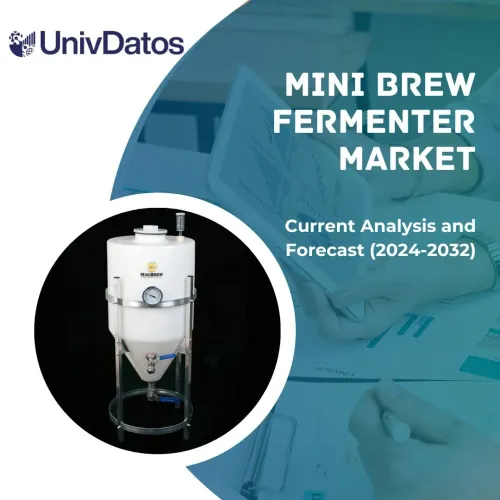- Home
- About Us
- Industry
- Services
- Reading
- Contact Us
Mini Brew Fermenter Market: Current Analysis and Forecast (2024-2032)
Emphasis on Material (Stainless Steel, Plastic, and Others); Capacity (Small (1-10 liters), Medium (10-30 liters), and Large (30-50 liters)); Automation (Fully Automatic and Semi-automatic); End-User (Breweries, Micro-Breweries, Food & Beverage Industry, and Household); and Region/Country
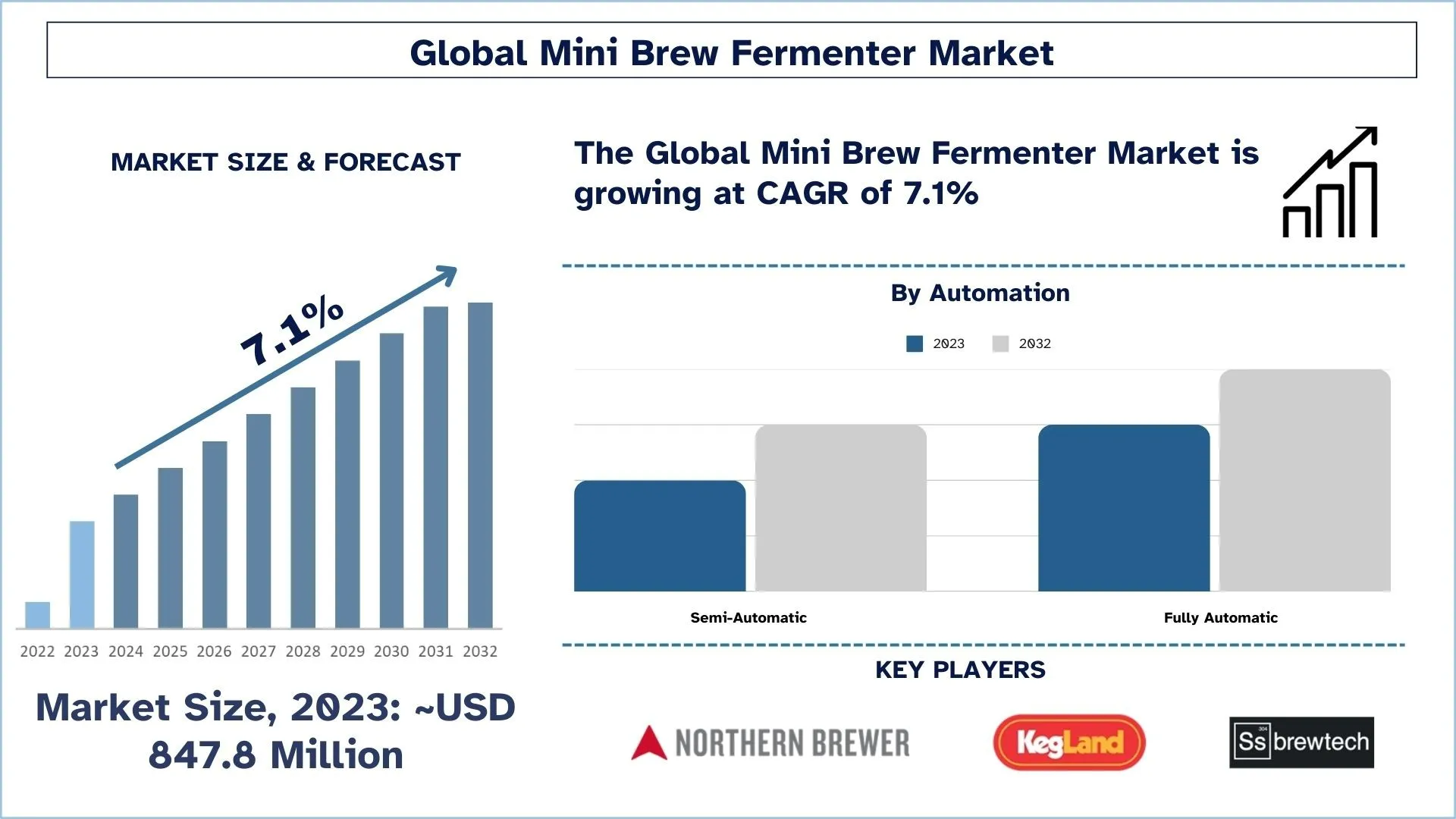
Global Mini Brew Fermenter Market Size & Forecast
The global mini brew fermenter market was valued at USD 847.8 Million in 2023 and is expected to grow at a strong CAGR of around 7.1% during the forecast period (2024-2032) owing to the expansion of online retail channels making mini brew fermenters more accessible to a global audience, boosting market reach and sales.
Mini Brew Fermenter Market Analysis
The mini brew fermenter market represents the business sector that manufactures compact brewing vessels suitable for domestic and small-scale commercial brewery use. Microbrewery fermenters present manufacturers along with home beer fans and little breweries with simplified operation while reducing price points for homemade beer production. The market expands because homebrewing popularity continues to rise and craft beer popularity increases together with brewing technology developments. The combination of rising demand for personalized premium beer with better incomes and leisure-time spending drives market expansion. The market keeps growing because of sustainability developments alongside rising do-it-yourself brewing interests.
Global Mini Brew Fermenter Market Trends
This section discusses the key market trends that are influencing the various segments of the global Mini Brew Fermenter market, as found by our team of research experts.
Fully Automatic Segment Transforming Industry
The fully automatic category is the largest contributor to the mini brew fermenter industry because consumers want no-fuss automated brewing systems. Compact fermenters now possess integrated automation which controls temperatures automatically while allowing users to monitor fermentation progress on mobile devices through digital interfaces. Homebrewers and professional beer makers who require more convenient and automated operations are choosing automated fermenters because they make their brewing processes faster and more efficient. The market sector will expand because AI, along with IoT technology, will continue advancing in brewing systems.
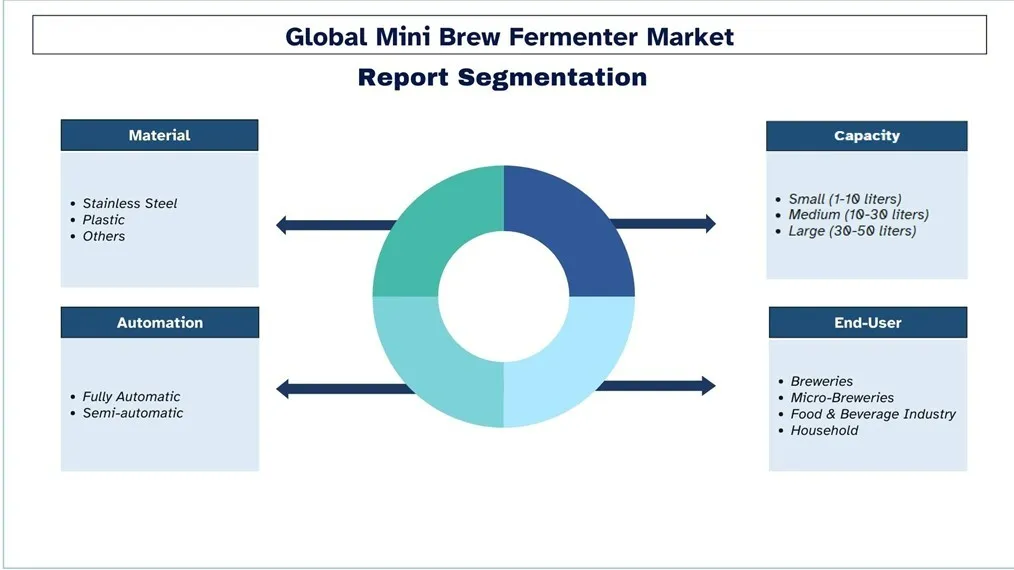
North America is expected to grow at a considerable rate during the forecast period.
The North American mini brew fermenter sector continues to grow because of a strong beer culture coupled with elevated incomes and rising homebrew activities. Advanced fermentation equipment receives substantial investment from small-scale brewers combined with hobbyists within the well-developed U.S. and Canadian craft beer sectors. The stainless-steel fermenter market together with automated fermenting devices experiences exceptional demand because of technological progress coupled with the customer preference for high-end beer production methods. In addition to the growing popularity of DIY brewing and sustainable approaches, the North American market maintains its status as a fundamental market for mini brew fermenters.
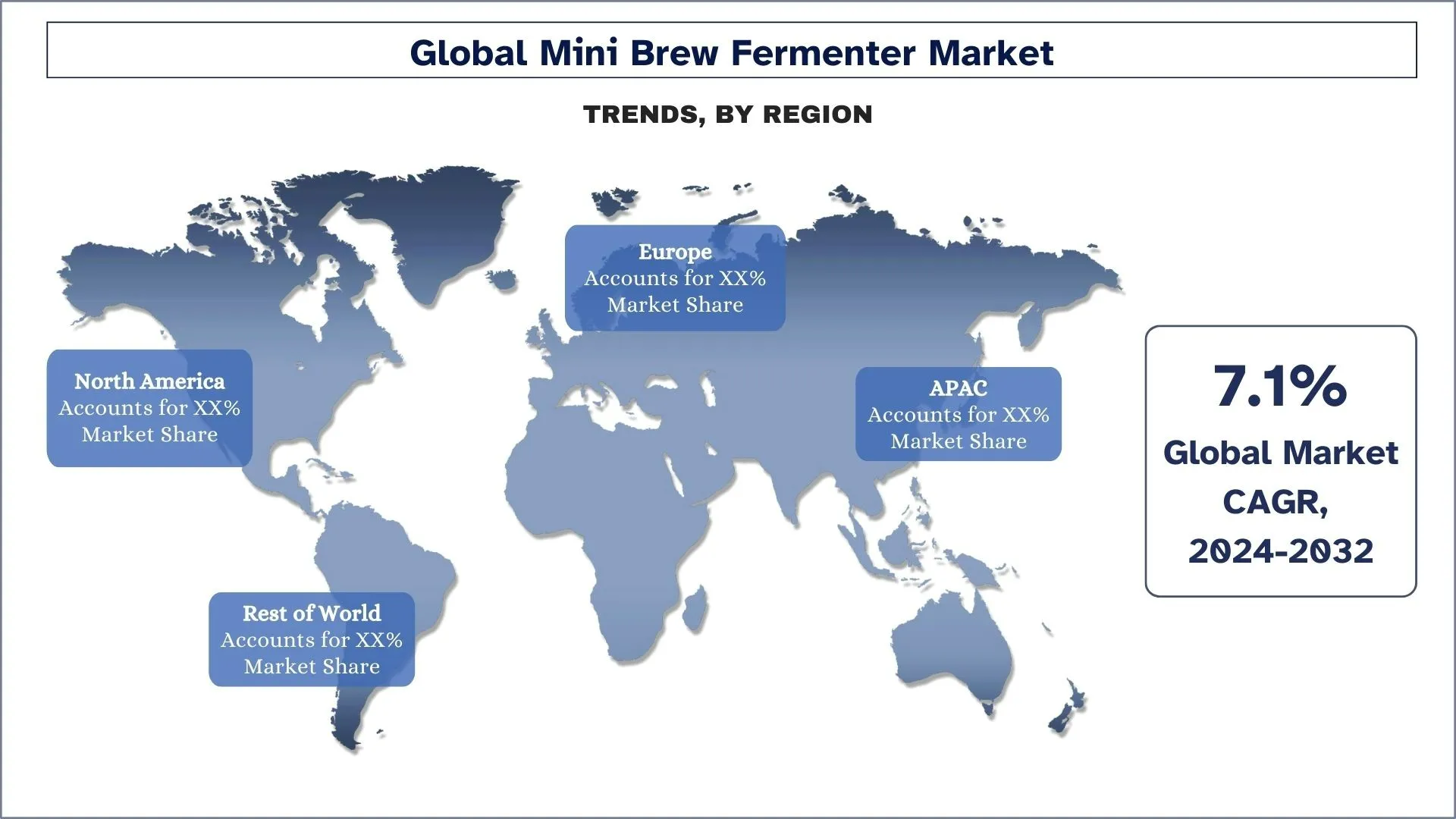
Global Mini Brew Fermenter Industry Competitive Landscape
The global mini brew fermenter market is competitive, with several global and international market players. The key players are adopting different growth strategies to enhance their market presence, such as partnerships, agreements, collaborations, new product launches, geographical expansions, and mergers and acquisitions.
Top Mini Brew Fermenter Manufacturing Companies
Some of the major players in the market are Grainfather Brewing Community; SPIKE; KegLand; Blichmann Engineering; WilliamsWarn; Krome Brewing; Ss Brewtech (Middleby); Northern Brewer (Blackstreet Capital Holdings, LLC), MINIBREW; Speidel Tank- und Behälterbau
Global Mini Brew Fermenter Market Report Coverage
Details | |
Base year | 2023 |
Forecast period | 2024-2032 |
Growth momentum | Accelerate at a CAGR of 7.1% |
Market size 2023 | USD 847.8 Million |
Regional analysis | North America, Europe, APAC, Rest of the World |
Major contributing region | North America is expected to dominate the market during the forecast period. |
Key countries covered | U.S., Canada, Germany, U.K., Spain, Italy, France, China, Japan, and India |
Companies profiled | Grainfather Brewing Community; SPIKE; KegLand; Blichmann Engineering; WilliamsWarn; Krome Brewing; Ss Brewtech (Middleby); Northern Brewer (Blackstreet Capital Holdings, LLC), MINIBREW; Speidel Tank- und Behälterbau |
Report Scope | Market Trends, Drivers, and Restraints; Revenue Estimation and Forecast; Segmentation Analysis; Demand and Supply Side Analysis; Competitive Landscape; Company Profiling |
Segments Covered | By Material; By Capacity; By Automation; By End-User; By Region/Country |
Reasons to buy this report:
- The study includes market sizing and forecasting analysis confirmed by authenticated key industry experts.
- The report briefly reviews overall industry performance at one glance.
- The report covers an in-depth analysis of prominent industry peers, primarily focusing on key business financials, type portfolios, expansion strategies, and recent developments.
- Detailed examination of drivers, restraints, key trends, and opportunities prevailing in the industry.
- The study comprehensively covers the market across different segments.
- Deep dive regional level analysis of the industry.
Customization Options:
The global mini brew fermenter market can further be customized as per the requirement or any other market segment. Besides this, UMI understands that you may have your own business needs, hence feel free to contact us to get a report that completely suits your requirements.
Table of Content
Research Methodology for the Global Mini Brew Fermenter Market Analysis (2024-2032)
Analyzing the historical market, estimating the current market, and forecasting the future market of the global Mini Brew Fermenter market were the three major steps undertaken to create and analyze the adoption of global Mini Brew Fermenter in major regions. Exhaustive secondary research was conducted to collect the historical market figures and estimate the current market size. Secondly, to confirm these insights, numerous findings and assumptions were considered. Moreover, exhaustive primary interviews were conducted with industry experts across the value chain of the global Mini Brew Fermenter market. For the assumption and validation of market numbers through primary interviews, we employed a top-down/bottom-up approach to forecasting the complete market size. Thereafter, market breakdown and data triangulation methods were adopted to estimate and analyze the market size of segments and sub-segments of the industry. The detailed method is explained below:
Analysis of Historical Market Size
Step 1: In-Depth Study of Secondary Sources:
A detailed secondary study was conducted to obtain the historical market size of the global Mini Brew Fermenter market through company internal sources such as annual reports & financial statements, performance presentations, press releases, etc., and external sources including journals & articles, government publications, competitor reports, third-party databases, and other credible publications.
Step 2: Market Segmentation:
After obtaining the historical market size of the global Mini Brew Fermenter market, we conducted a detailed secondary analysis to gather historical market insights and share for different segments & sub-segments for major regions. Major segments, such as material, capacity, automation, end-user, and region, are included in the report. Further country-level analysis was conducted to evaluate the overall adoption of testing models in that region.
Step 3: Factor Analysis:
After acquiring the historical market size of different segments and sub-segments, we conducted a detailed factor analysis to estimate the current market size of the global Mini Brew Fermenter market. Further, we conducted factor analysis using dependent and independent variables such as material, capacity, automation, end-user, and global Mini Brew Fermenter market regions. A thorough analysis of demand and supply-side scenarios was conducted considering top partnerships, mergers and acquisitions, business expansion, and product launches in the global Mini Brew Fermenter market.
Current Market Size Estimate & Forecast
Current Market Sizing: Based on actionable insights from the above 3 steps, we arrived at the current market size, key players in the global Mini Brew Fermenter market, and market shares of the segments. All the required percentage shares split, and market breakdowns were decided using the above-mentioned secondary approach and were verified through primary interviews.
Estimation & Forecasting: For market estimation and forecast, weights were assigned to several factors including drivers & trends, restraints, and opportunities available for the stakeholders. After analyzing these factors, relevant forecasting techniques, i.e., the top-down/bottom-up approach were applied to arrive at the market forecast for 2032 for different segments and sub-segments across the major markets globally. The research method adopted to estimate the market size encompasses:
- The industry’s market size, in terms of revenue (USD) and the adoption rate of the global Mini Brew Fermenter market across the major markets domestically
- All percentage shares, splits, and breakdowns of market segments and sub-segments
- Key players in the global Mini Brew Fermenter market in terms of the types offered. Also, the growth strategies adopted by these players to compete in the fast-growing market.
Market Size and Share Validation
Primary Research: In-depth interviews were conducted with the Key Opinion Leaders (KOLs) including Top Level Executives (CXO/VPs, Sales Head, Marketing Head, Operational Head, Regional Head, Country Head, etc.) across major regions. Primary research findings were then summarized, and statistical analysis was performed to prove the stated hypothesis. Inputs from primary research were combined with secondary findings, hence turning information into actionable insights.
Split of Primary Participants in Different Regions
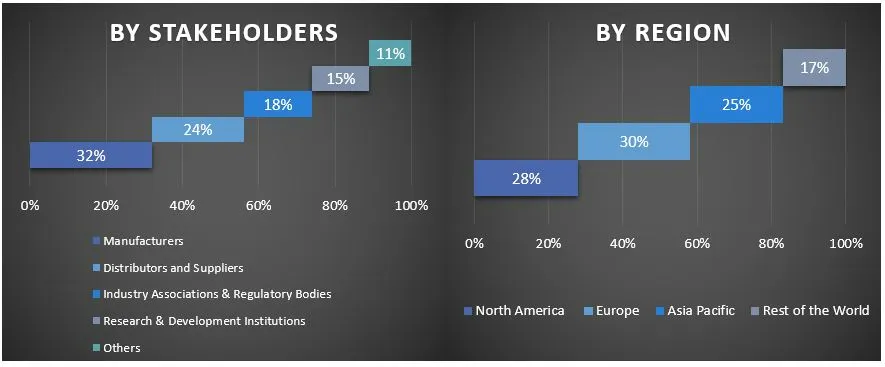
Market Engineering
The data triangulation technique was employed to complete the overall market estimation and to arrive at precise statistical numbers for each segment and sub-segment of the global Mini Brew Fermenter market. After studying various parameters and trends in the global Mini Brew Fermenter market's material, capacity, automation, end-user, and regions, data was split into several segments and sub-segments.
The Main Objective of the Global Mini Brew Fermenter Market Study
The current & future market trends of the global Mini Brew Fermenter market were pinpointed in the study. Investors can gain strategic insights to base their discretion for investments on the qualitative and quantitative analysis performed in the study. Current and future market trends determined the market's overall attractiveness at a regional level, providing a platform for the industrial participant to exploit the untapped market to receive help from a first-mover advantage. Other quantitative goals of the studies include:
- Analyze the current forecast and market size of the global Mini Brew Fermenter market in terms of value (USD). Also, analyze the current forecast and market size of different segments and sub-segments.
- Segments in the study include areas of material, capacity, automation, end-user, and regions.
- Define and analyze the regulatory framework for the industry.
- Analyze the value chain involved with the presence of various intermediaries, along with analyzing customer and competitor behaviors of the industry.
- Analyze the current and forecast market size of the global Mini Brew Fermenter market for the major regions.
- Major countries of regions studied in the report include Asia Pacific, Europe, North America, and the Rest of the World.
- Company profiles of the global Mini Brew Fermenter market and the growth strategies the players adopt to sustain the fast-growing market.
- Deep dive regional level analysis of the industry
Frequently Asked Questions FAQs
Q1: What is the global Mini Brew Fermenter market’s current market size and growth potential?
The global Mini Brew Fermenter market was valued at USD 847.8 Million in 2023 and is expected to grow at a CAGR of 7.1% during the forecast period (2024-2032).
Q2: What are the driving factors for the growth of the global Mini Brew Fermenter market?
The rising popularity of craft beer and home brewing has increased demand for mini brew fermenters, allowing enthusiasts to experiment with unique flavors and techniques.
Q3: Which segment has the largest global Mini Brew Fermenter market share by automation category?
The fully automatic category has the largest share of the global Mini Brew Fermenter market by automation segment.
Q4: What are the emerging technologies and trends in the global Mini Brew Fermenter market?
Advancements like temperature control, airlock systems, and smart connectivity provide greater precision and convenience, attracting both beginners and experienced brewers.
Q5: Which regions dominate the global Mini Brew Fermenter market?
North America is expected to dominate the market during the forecast period.
Related Reports
Customers who bought this item also bought



